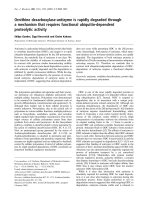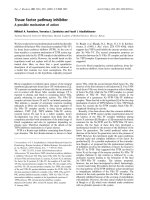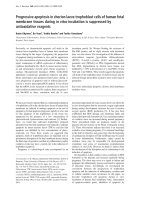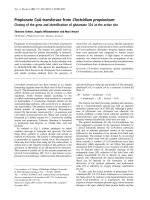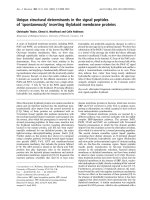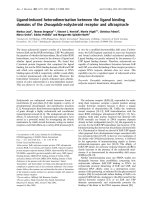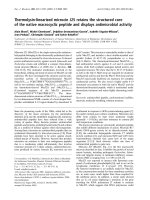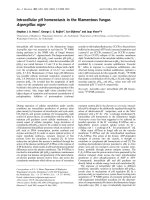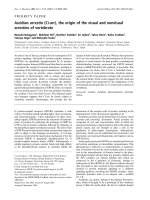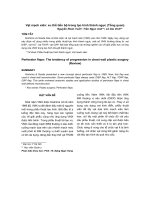Báo cáo Y học: Thermolysin-linearized microcin J25 retains the structured core of the native macrocyclic peptide and displays antimicrobial activity doc
Bạn đang xem bản rút gọn của tài liệu. Xem và tải ngay bản đầy đủ của tài liệu tại đây (383.56 KB, 11 trang )
Thermolysin-linearized microcin J25 retains the structured core
of the native macrocyclic peptide and displays antimicrobial activity
Alain Blond
1
, Michel Cheminant
1
, Delphine Destoumieux-Garzo
´
n
1
, Isabelle Se
´
galas-Milazzo
2
,
Jean Peduzzi
1
, Christophe Goulard
1
and Sylvie Rebuffat
1
1
Laboratory of Chemistry and Biochemistry of Natural Substances, Department of Regulation, Development and
Molecular Diversity, National Museum of Natural History, Paris, France;
2
IRCOF, ECOBS, UMR 6014 CNRS,
IFRMP 23, University of Rouen, France
Microcin J25 (MccJ25) is the single macrocyclic antimicro-
bial peptide belonging to the ribosomally synthesized class of
microcins that are secreted by Enterobacteriaceae.Itshowed
potent antibacterial activity against several Salmonella and
Escherichia strains and exhibited a compact three-dimen-
sional structure [Blond et al. (2001) Eur. J. Biochem., 268,
2124–2133]. The molecular mechanisms involved in the
biosynthesis, folding and mode of action of MccJ25 are still
unknown. We have investigated the structure and the anti-
microbial activity of thermolysin-linearized MccJ25
(MccJ25-L
1)21
: VGIGTPISFY
10
GGGAGHVPEY
20
F), as
well as two synthetic analogs, sMccJ25-L
1)21
(sequence of
the thermolysin-cleaved MccJ25) and sMccJ25-L
12)11
(C-terminal sequence of the MccJ25 precursor:
G
12
GAGHVPEYF
21
V
1
GIGTPISFYG
11
). The three-
dimensional solution structure of MccJ25-L
1)21
, determined
by two-dimensional NMR, consists of a boot-shaped hair-
pin-like well-defined 8–19 region flanked by disordered N
and C termini. This structure is remarkably similar to that of
cyclic MccJ25, and includes a short double-stranded anti-
parallel b-sheet (8–10/17–19) perpendicular to a loop
(Gly11–His16). The thermolysin-linearized MccJ25-L
1)21
had antibacterial activity against E. coli and S. enteritidis
strains, while both synthetic analogues lacked activity and
organized structure. We show that the 8–10/17–19 b-sheet,
as well as the Gly11–His16 loop are required for moderate
antibacterial activity and that the Phe21–Pro6 loop and the
MccJ25 macrocyclic backbone are necessary for complete
antibacterial activity. We also reveal a highly stable 8–19
structured core present in both the native MccJ25 and the
thermolysin-linearized peptide, which is maintained under
thermolysin treatment and resists highly denaturing condi-
tions.
Keywords: antimicrobial peptide; conformational stability;
microcin; molecular modeling; solution structure.
Since the pioneering works of the 1980s, which led to the
discovery of the insect cecropins [1], the mammalian
defensins [2,3] and the amphibian magainins [4], numerous
antimicrobial peptides have been isolated from a wide
variety of species. Many bacteria produce antimicrobial
peptides and proteins, including bacteriocins [5] and colicins
[6], as a method of defence against other microorganisms.
Among them, microcins are antimicrobial peptides that are
synthesized ribosomally by Enterobacteriaceae [7,8]. These
peptides have been reported to be active against closely
related species of bacteria. However, bacteria that produce
microcins are resistant to their own endogenous peptides
due to a mechanism called self-immunity that involves
resistance proteins [7]. Unlike colicins, antimicrobial pro-
teins produced by enteric bacteria [6], microcins are not
synthesized in response to SOS system-inducing agents [7],
but under nutrient-poor culture conditions. Microcins also
differ from colicins by their lower molecular weight
(generally < 10 kDa), and their resistance to extreme pH
and temperature conditions.
The known microcins are structurally unrelated peptides
that exhibit different mechanisms of action. Microcin B17
blocks DNA-gyrase activity by its thiazole/oxazole rings
[9,10], the nucleotide heptapeptide microcin C7 inhibits
protein synthesis [11], and microcins E492 and ColV form
transmembrane channels that cause lysis of the target
organisms [12,13]. Such diversity within one class of
antimicrobial peptides is quite rare.
Microcin J25 (MccJ25, Fig. 1) is the first macrocyclic
microcin described to date. It inhibits the growth of several
enteric bacteria, including pathogenic Escherichia, Salmo-
nella and Shigella strains, at minimum inhibitory concen-
trations (MICs) ranging from 1 to 100 n
M
[14,15].
MccJ25 was reported to interact with liposomes com-
posed of zwitterionic phospholipids [16], and to act on the
cytoplasmic membrane of S. newport [17]. However,
the bacterial membrane is an unlikely target for MccJ25,
as the concentrations needed for these membrane activities
are, in some cases, much higher than those required for
the antibiotic action. In addition, a recent study showed
that an E. coli strain displaying a mutation in the gene
encoding the RNA polymerase b¢ subunit is resistant
to MccJ25, which suggests that RNA polymerase could
Correspondence to S. Rebuffat, Laboratoire de Chimie et Biochimie
des Substances Naturelles, Muse
´
um National d’Histoire Naturelle,
63 rue Buffon, 75231 Paris, Cedex 05, France.
Fax:+33140793135,Tel.:+33140793118,
E-mail: rebuff
Abbreviations: Mcc, microcin; MIC, minimum inhibitory concentra-
tion; PB, poor broth; CSD, chemical shift deviations; RTD-1,
rhesus theta-defensin-1; SFTI-1, sunflower trypsin inhibitor; TMS,
tetramethylsilane.
(Received 22 August 2002, revised 21 October 2002,
accepted 30 October 2002)
Eur. J. Biochem. 269, 6212–6222 (2002) Ó FEBS 2002 doi:10.1046/j.1432-1033.2002.03340.x
be the intracellular target for the microcin [18]. To date,
the precise mechanism of action of MccJ25 remains
unknown.
The 21-residue primary structure [19], and the three-
dimensional NMR solution structure [20] of cyclic MccJ25
have been determined. The peptide forms a distorted
antiparallel b-sheet, which twists and folds back on itself.
Residues 7–10 and 17–20 form the more regular part of the
b-sheet between the Phe21–Pro6 and Gly11–His16 loops. A
cavity delimited by two crab pincer-like regions that
encompass residues 6–8 and 18–1, confines the Val1 and
Ser8 side chains. The compact core structure is very well
defined, stabilized primarily by the hydrogen bonds of a
tightly packed b-sheet.
In this study, we examined the solution structure,
stability, and antimicrobial activity of the thermolysin-
linearized MccJ25 (MccJ25-L
1)21
: VGIGTPISFY
10
GGG
AGHVPEY
20
F), previously generated for the structural
characterization of MccJ25 [19], the synthetic analog
sMccJ25-L
1)21
, and the synthetic 21-residue sMccJ25-
L
12)11
peptide (G
12
GAGHVPEYF
21
V
1
GIGTPISFYG
11
),
which sequence derives from MccJ25 precursor (Fig. 1).
Despite identical sequences, the folding and activity of the
enzymatically generated MccJ25-L
1)21
and chemically syn-
thesized sMccJ25-L
1)21
were completely different. This
finding was used as a basis to discuss the high stability of the
MccJ25 structured core and its involvement in the antibac-
terial activity.
EXPERIMENTAL PROCEDURES
MccJ25 and MccJ25-L
1)21
sample preparation
Native MccJ25 was purified according to the procedure
described previously [19]. Briefly, E. coli J02
Mcc+
(a
generous gift from A M. Pons, Universite
´
de La
Rochelle, France) was grown in 2 L M63 minimal
medium and the culture supernatant was applied onto a
C8 Sep-Pak cartridge (Waters, France). Two successive
elution steps were performed with (50 : 50, v/v) and
(80 : 20, v/v) methanol/water mixtures. MccJ25, found in
the (80 : 20) methanol/water Sep-Pak fraction, was further
purified on an RP-HPLC semipreparative column (Cap-
cell C18, 5 lm, 7.5 · 250 cm; Interchim, France) under
isocratic conditions in a (61 : 39) methanol/water mixture
containing 0.05% CF
3
COOH. Separation was performed
at a 2 mLÆmin
)1
flow rate, and absorbance was monitored
at 226 nm.
MccJ25-L
1)21
was obtained by thermolysin-digestion of
native MccJ25. Typically, 1 lmol MccJ25 was dissolved in
8
M
urea (600 lL) and incubated at 46 °C for 30 min,
before the addition of 0.17
M
NH
4
HCO
3
(1200 lL), 10 m
M
CaCl
2
(200 lL) and 40 lg thermolysin (Boehringer Mann-
heim). The digestion was performed at 46 °C, pH 8.0, for
60 min. The reaction was stopped by adding 400 lL acetic
acid, and MccJ25-L
1)21
was purified by RP-HPLC on an
Inertsil ODS2 column (5 lm, 4.6 · 250 mm; Interchim,
France) under isocratic elution in a (31 : 69, v/v) acetonit-
rile/water solution containing 0.1% CF
3
COOH (flow rate:
1mLÆmin
)1
). Absorbance was monitored at 226 nm. Purity
of MccJ25-L
1)21
was ascertained by MALDI-TOF MS on
an Applied Biosystem Applera (USA) Voyager De-Pro
system used in a positive linear mode, with sinapinic acid as
a matrix. Calibration was performed with a mixture of
standards including bovine insulin (MH
+
at m/z 5734.59),
thioredoxin (MH
+
at m/z 11674.48) and apomyoglobin
(MH
+
at m/z 16952.56) (Applied Biosystems).
Peptide synthesis and purification
sMccJ25-L
1)21
(VGIGTPISFY
10
GGGAGHVPEY
20
F) and
sMccJ25-L
12)11
(G
12
GAGHVPEYF
21
V
1
GIGTPISFYG
11
)
were synthesized by the classical solid-phase methodology
using Fmoc-protection, as described by Neimark and Briand
[21]. All RP-HPLC separations were performed with solvents
acidified with 0.05% CF
3
COOH. The sMccJ25-L
1)21
sample
was purified in two steps on an RP-HPLC C18 column
(semipreparative Capcell, 5 lm; 7.5 · 250 mm; Interchim)
used at a flow-rate of 2 mLÆ min
)1
. The first separation was
performed under isocratic elution with a (27 : 73) acetonit-
rile/water mixture, whereas the second separation consisted
of a (40 : 60) to (60 : 40) methanol/water linear gradient at
0.7% methanolÆmin
)1
.ThesMccJ25-L
12)11
sample was
purified in two steps on the same column as sMccJ25-L
1)21
at a flow-rate of 2 mLÆ min
)1
. The first RP-HPLC separation
was performed with a biphasic gradient composed of a 10-
min isocratic step in a (26 : 74) acetonitrile/water mixture,
followed by a 26 : 74 to 28 : 72 acetonitrile/water flat linear
gradient (0.4% acetonitrileÆmin
)1
). The second HPLC con-
sisted of an isocratic elution with a (30 : 70) acetonitrile/
water mixture. Absorbance was monitored at 226 nm.
Antibacterial assays
Antibacterial activity of MccJ25, MccJ25-L
1)21
, sMccJ25-
L
1)21
and sMccJ25-L
12)11
was assayed against two bacteria
highly sensitive to MccJ25. The test microorganisms,
E. coli MC4100 tolC
–
and S. enteritidis, were kindly
provided by M. Lavin
˜
a (Facultad de Ciencias, Montevi-
deo, Uruguay) and A M. Pons (Universite
´
de La Rochelle,
France), respectively. Concentrations of peptide stock
solutions were determined by amino acid composition, as
described previously [19]. MICs were determined in
triplicate in poor broth (PB: 1% bactotryptone, 0.5%
NaCl w/v) by the liquid growth inhibition assay essentially
as described [22]. Briefly, in a sterile microtitration plate,
10 lL peptide, or deionized water as a control, were added
to 90 lL of a mid-logarithmic growth phase culture of
Fig. 1. Amino acid sequences of the naturally occurring cyclic MccJ25
anditslinearvariants.MccJ25-L
1)21
is the thermolysin-linearized
MccJ25, previously named MccJ25-L in [19]. MccJ25-L
12)11
displays
the sequence of the 21 last amino acids of pre-MccJ25 (mcjA gene
product). The synthetic peptides are identified by an s before their
name. Amino acids are numbered according to [19].
Ó FEBS 2002 Structure of thermolysin-linearized microcin J25 (Eur. J. Biochem. 269) 6213
bacteria diluted in PB to D
600
¼ 0.001. Plates were
incubated for 16 h at 30 °C with vigorous shaking and
monitored spectrophotometrically at 620 nm on a Ceres
900 (Bio-Tek Instruments) plate reader. MICs are
expressed as the interval of concentration [a]–[b], where
[a] is the highest concentration tested at which microbial
growth can be observed and [b] is the lowest concentration
that causes 100% growth inhibition [23].
CD spectroscopy
CD spectra were recorded at room temperature from 250 to
190 nm on a Jobin-Yvon Mark V dichrograph (Longjum-
eau, France), using a 0.05-mm path cell. The spectra were
measured for methanolic solutions at peptide concentra-
tions of 0.05–1 m
M
.
NMR spectroscopy
Samples(0.5mL)of6m
M
MccJ25-L
1)21
, sMccJ25-L
1)21
and sMccJ25-L
12)11
in methanol (CD
3
OH) were placed in
5-mm Wilmad tubes for the NMR experiments. Data were
acquired on Bruker AVANCE 400 and DMX 600 spec-
trometers, equipped with
1
H-broad-band reverse gradient
and triple resonance
1
H-
13
C-
15
N-gradient probeheads,
respectively. Temperature, controlled by a Bruker BCU-05
refrigeration unit and a BVT 3000 control unit on both
spectrometers, was set at 10 °C unless specified otherwise.
Data were collected and processed on a Silicon Graphics O2
workstation, using the Bruker
XWIN-NMR
and
AURELIA
softwares.
1
Hand
13
C chemical shifts were referenced to
the central component of the quintet due to the CD
2
HOH
and the CD
3
OH resonances of methanol taken at
3.313 p.p.m and at 49.00 p.p.m. downfield from TMS,
respectively. The following conventional two-dimensional
homonuclear spectra were recorded: double quantum
filtered (DQF) COSY, TOCSY with MLEV17 mixing
period of 120 ms, NOESY with different mixing times, and
1
H-
13
C heteronuclear experiments, optimized for J-values of
135 Hz (HSQC) and 7 Hz (HMBC). Methods of spectra
recording and data processing are described elsewhere [20].
NOE buildup curves for MccJ25-L
1)21
(mixing times of 50,
100, 150, 200 and 400 ms) showed that the correlation
remained linear for the 100 ms mixing time, which was
selected for distance calculation.
Temperature coefficients of amide protons were obtained
in the range of 10–35 °C, by acquiring six series of one-
dimensional (1D)-
1
H and TOCSY spectra at 400.13 MHz,
using 5 °C temperature increments. Exchange of amide
protons was monitored as described previously [20]. Briefly,
a normal isotopic sample (either MccJ25-L
1)21
or sMccJ25-
L
1)21
) was dissolved in CD
3
OD at 0 °C. It was analysed for
2hat0°C and over 3 days at 20 °C by the acquisition of a
series of 1D-
1
H and TOCSY spectra.
Experimental restraints and MccJ25-L structure
calculations
Distance restraints for MccJ25-L
1)21
structure calculation
were derived from NOE cross-peaks in the NOESY
spectrum recorded at 10 °Cwiths
m
¼ 100 ms, that in turn
were converted into distances by volume integration using
the
AURELIA
software (Bruker, Karlsruhe). The NOE
intensity between the Tyr20 Hd and He protons, which
corresponds to a distance of 2.45 A
˚
, was used for calibra-
tion. To ascertain whether the contribution of zero-quan-
tum coherence to the Tyr20 Hd–He cross-peak was
negligible, the consistency of the distances obtained was
assessed by referring to the Tyr10 Hd)He distance and to
the Pro6 and Pro18 d-methylene distances. A range
of ± 25% the calculated distance was used to define the
upper and lower bounds of the restraints. Appropriate
pseudoatom corrections were applied [24] to nonstereospe-
cifically assigned methyl and methylene protons. A total of
223 upper and lower distance restraints and 15 ambiguous
restraints, derived from the NOE data, were used for the
structure calculations. Eight / dihedral angles, measured
at 10 °C from the 1D- and the high digital resolution
DQF-COSY spectra (CD
3
OH), were restrained to
)120 ± 25° for
3
J
NHCaH
P 9.5 Hz (Phe9, Val17),
)120 ± 45° for a
3
J
NHCaH
in the range 8.1–8.9 Hz (Ser8,
Tyr20, Phe21) and )120 ± 50° for a
3
J
NHCaH
6 8.0 Hz
(Thr5, Tyr10, Glu19). Two v
1
dihedral angles, derived from
the
3
J
CaHCbH
coupling constants measured in the
DQF-COSY (CD
3
OD) as well as from the intraresidue
NOE intensities, were restrained to +60 ± 45° (Tyr10),
and 180 ± 45° (Val17). Hydrogen bonding restraints were
not included in the calculations.
Structures were calculated in vacuo, as described else-
where [20], using simulated annealing and energy minimi-
zation protocols within the
X
-
PLOR
version 3.851 software
[25], run either on a Silicon Graphics O2 workstation (
IRIX
6.5), or a Gateway computer (
SUSE LINUX
7.0). The target
function was similar to that used by Nilges et al.[26].
Briefly, a set of 100 structures was generated using random
/, w dihedral angles and extended side chains, and taking
into account the distance and angle restraints. The ambi-
guous assignments were further used with the appropriate
treatment in
X
-
PLOR
[27,28]. During the processing, the
distance restraint force was kept at 50 kcalÆmol
)1
ÆA
˚
)2
and
the NOE intensities were averaged with the ÔsumÕ option. Of
the 100 structures generated, 80 had a total energy less than
25 kcalÆmol
)1
and led in all cases to systematic distance and
dihedral angle violations lower than 0.2 A
˚
and 5°, respect-
ively. Refinement of the structures was achieved using the
conjugate gradient Powell algorithm with 7000 cycles of
energy minimization and the
CHARMM 22
force field [29]. The
30 best structures on the basis of their total energy including
the electrostatic term with no systematic distance violation
larger than 0.2 A
˚
and no dihedral angle violation greater
than 5° were selected as the final structure of MccJ25-L
1)21
.
The structures were visualized and analysed on the Silicon
Graphics O2 and Gateway workstations, using the
X
-
PLOR
[25],
MOLMOL
[30] and
PROCHECK
_
NMR
[31] programs. The
hydrogen bonds present in the final structures were
identified with
MOLMOL
, using the distances determined
between donor and acceptor and the corresponding devi-
ation angles with respect to 180°, with either: distance
<2.7 A
˚
, deviation angle < 35° (NH
12
fi CO
9
,
NH
10
fi CO
17
), or distance < 3.0 A
˚
, deviation angle
<40° (NH
19
fi CO
8
,NH
9
fi CO
13
,NH
13
fi CO
9
), or
distance < 3.0 A
˚
, deviation angle < 50° (NH
11
fi CO
9
,
NH
14
fi CO
12
) in all the selected structures.
The coordinates for the family of 20 refined lowest energy
structures were deposited in the Brookhaven Protein Data
Bank, under the accession code 1GR4.
6214 A. Blond et al. (Eur. J. Biochem. 269) Ó FEBS 2002
Stability of MccJ25 and MccJ25-L
1)21
to denaturing
conditions
Thermal stability of MccJ25-L
1)21
and MccJ25 was exam-
ined between 25 and 165 °C by NMR spectroscopy, using a
2.5 m
M
solution in dimethylsulfoxide-d6. In preliminary
TOCSY (spin-lock time 120 ms) and NOESY (mixing time
300 ms) experiments, sequential assignments were obtained
at 25 °C and similarity of the global fold in both CD
3
OH
and dimethylsulfoxide-d6 was ascertained. The NH and Ha
chemical shifts of Ser8, Phe9, Tyr10, Ala14, His16, Val17
and Glu19, were selected to probe the temperature-induced
conformational transitions. They were determined at 25, 45,
65, 90, 115, 140 and 165 °C, from seven series of 1D-
1
Hand
TOCSY spectra. Changes in the slopes of the Ha and NH
proton curves obtained by plotting the chemical shifts as a
function of temperature were interpreted as conformational
changes. The reversibility of the denaturation process was
checked at 115 and 165 °C, by slowly lowering the
temperature to 25 °C and acquiring control 1D-
1
Hand
TOCSY spectra. The acquisition time of the NMR spectra
at each temperature was fixed at 2 h.
Analytical grade urea and guanidinium hydrochloride
used in denaturation studies were purchased from Merck
(Darmstadt, Germany). A series of experiments using
different denaturing agents (1–6
M
guanidinium hydro-
chloride or 1–8
M
urea in water) and temperature
conditions (25–95 °C) were used to assay MccJ25-L
1)21
stability. For high temperature conditions, sealed tubes
were used. Over the reaction time course, aliquots of the
peptide/denaturant mixtures were withdrawn at different
incubation times and analysed by RP-HPLC on a C18
lBondapak column (4.6 · 250 mm; Waters, France)
under isocratic conditions with 0.05% CF
3
COOH-con-
taining (32 : 68) acetonitrile/water mixture at a flow rate
of 1 mLÆmin
)1
. At the end of the incubation period, the
reaction mixture was cooled to room temperature and
applied onto a C8 Sep-Pak cartridge (Waters, France),
which stopped the reaction by removing the chaotropic
agent. Elution was performed in a stepwise manner by
0.05% CF
3
COOH-containing 0 : 100, 25 : 75, and 45 : 55
acetonitrile/water mixtures. MccJ25-L
1)21
, found in the
(45 : 55) fraction, was dried under vacuum and analysed
by HPLC, as described above and by NMR. 1D-
1
H,
TOCSY and NOESY spectra were performed in CD
3
OH
and compared to the original reference spectra.
RESULTS
Generation of MccJ25 linear variants: MccJ25-L
1)21
,
s
MccJ25-L
1)21
and
s
MccJ25
12)11
Native MccJ25 was prepared according to the procedure
described previously [19]. After purification, the peptide
preparation analysed by MALDI-TOF MS presented a
single MH
+
ion at m/z ¼ 2108.40, in agreement with the
calculated mass at 2107 Da for the macrocyclic MccJ25.
Three linear forms of MccJ25 were obtained, either by
MccJ25 thermolysin cleavage (MccJ25-L
1)21
initially called
MccJ25-L [19] or by chemical synthesis (sMccJ25-L
1)21
and
sMccJ25-L
12)11
; Fig. 1). The sequences chosen for the
synthetic peptides are identical to those of the thermolysin-
cleaved MccJ25 (sMccJ25-L
1)21
) and of the 21-residue
C-terminal end of the MccJ25 precursor (sMccJ25-L
12)11
).
The three linear peptides were purified by RP-HPLC and
their purity was ascertained by MALDI-TOF MS. The
measured masses for all three peptides (MH
+
at m/z
2126.08 for MccJ25-L
1)21
, 2125.70 for sMccJ25-L
1)21
and
[M+Na]
+
at m/z 2147.47 for MccJ25-L
12)11
)werein
agreement with the expected molecular masses at 2125 Da.
Antibacterial activity
The antibacterial activity of MccJ25 linear variants was
examined by a liquid growth inhibition assay using two
Gram-negative strains chosen for their high sensitivity to the
native MccJ25. Contrary to the native cyclic peptide, which
displayed MIC values at 0–2 n
M
and 2–5 n
M
against
S. enteritidis and E. coli MC4100 tolC
–
, respectively, the
synthetic linear peptides sMccJ25-L
12)11
and sMccJ25-L
1)21
were completely inactive at concentrations reaching 10 l
M
against the two test bacteria (Table 1). By contrast, the
thermolysin-linearized microcin (MccJ25-L
1)21
)retained
significant activity against both Salmonella and Escherichia
strains, as indicated by MIC values of 80–150 n
M
and 300–
600 n
M
, respectively. This led us to examine the three-
dimensional structures of these linear MccJ25 variants, with
particular attention to MccJ25-L
1)21
, following the hypo-
thesis that structural features essential to MccJ25 activity
had most likely been retained in this linear form.
Peptide solubility and aggregation state
Due to insolubility of MccJ25 and its linear variants in
aqueous medium in the absence of denaturing agents, CD
and NMR spectroscopic analyses were performed utilizing
methanol, a solvent in which MccJ25 is extremely soluble
[20]. The CD spectrum of MccJ25-L
1)21
at 0.1 m
M
(data not
shown) was very similar to that obtained previously for
MccJ25 [20]. It presented a strong negative band at 193 nm,
as well as a positive band centred at 210 nm, which did not
enable the assignment of any defined secondary structure.
The aggregation state of MccJ25-L
1)21
was evaluated by
recording several CD spectra at concentrations ranging
from 0.05 to 1 m
M
. The similarity in the patterns obtained
at the various concentrations indicated the absence of
aggregation below 1 m
M
. In addition, 1D-
1
HandTOCSY
spectra performed for concentrations between 1 and 6 m
M
,
did not show any significant variation of the amide and a
Table 1. Minimum inhibitory concentrations of MccJ25 linear variants
against S. enteritidis and E. coli MC4100 tolC
)
. MICs were deter-
mined in triplicate according to the liquid growth inhibition assay.
MICs (n
M
) are expressed as intervals of concentrations [a]–[b] were [a]
is the highest concentration tested at which the microorganisms are
growing and [b] is the lowest concentration that causes 100% growth
inhibition [21]. NA, Not active in the range 0–10 l
M
.
Peptide S. enteritidis E. coli MC4100 tolC
–
MccJ25 0–2 2–5
MccJ25-L
1)21
80–150 300–600
sMccJ25-L
1)21
NA NA
sMccJ25-L
12)11
NA NA
Ó FEBS 2002 Structure of thermolysin-linearized microcin J25 (Eur. J. Biochem. 269) 6215
proton chemical shifts, ensuring that MccJ25-L
1)21
will not
aggregate in methanol when performing NMR.
sMccJ25-L
1)21
was also quite soluble in methanol,
showing weak negative and positive bands centred at
190 nm, and 197 nm, respectively (data not shown). CD
spectra could not be acquired for sMccJ25-L
12)11
, due to its
poor solubility in methanol. Dimethylsulfoxide-d6was
finally chosen for the NMR study of this variant, and was
also used to assay the thermal stability of MccJ25- L
1)21
.
Sequential assignments and secondary structures
All proton resonances of MccJ25-L
1)21
were obtained at
10 °C, to ensure a good signal separation. The standard
sequence-specific assignment strategy was used [32]. TOC
SY and DQF-COSY spectra enabled the identification of
amino acid spin systems, and NOESY data provided the
sequential connections between these spin systems. In
addition, backbone and side-chain
13
C resonances were
assigned from the
1
H-
13
C HSQC and HMBC data. The two
proline residues found in MccJ25-L
1)21
(Pro6 and Pro18),
both displayed the typical NOE pattern of strong aH
i-1
-dH
i
accounting for a trans conformation of the X-Pro amide
bonds. This was in agreement with the c-carbon
13
C
chemical shifts of these proline residues. Taking into
account the S configuration of their a carbons, the pro-R
and pro-S ring protons of Pro6 and Pro18 were assigned
stereospecifically in MccJ25-L
1)21
from the intraresidue
NOE networks.
The sequential assignments of sMccJ25-L
1)21
and
sMccJ25-L
12)11
were obtained in CD
3
OH and dimethyl-
sulfoxide-d6, respectively. In both sMccJ25-L
1)21
and
sMccJ25-L
12)11
NOESY spectra, the aH
i-1
-dH
i
cross-peaks
that characterize a trans conformation of the X-Pro amide
bonds were observed for Pro6 and Pro18, while no
contribution from cis conformation could be detected. In
addition, the proline c-carbon
13
C chemical shifts were in
agreement with two trans proline residues in sMccJ25-L
1)21
.
The Ha and Ca secondary chemical shifts (chemical shift
deviations, CSD), which represent the difference between
the observed chemical shifts and the random coil values of
Wishart [33,34], were determined for MccJ25-L
1)21
.Mostof
the residues had chemical shifts that differed from the
random coil values by more than 0.1 p.p.m., indicative of a
structured peptide. The CSD did not show any clear
evidence of a-helix (upfield shifts) or b-sheet (downfield
shifts) structure in the peptide (Fig. 2). An irregular pattern
of positive and negative or null values, relevant to the
presence of turns, was highly similar to that observed for the
cyclic MccJ25, mainly in the region comprising residues 5–
18 [20]. The pattern of sequential, medium- and long-range
NOEs (Fig. 3) showed a series of strong daN
i,i+1
, very few
dNN
i,i+1
, several daN
i,j
and dNa
i,j
contacts involving the
residues belonging to the 8–10 and 16–19 regions, and a
strong daa
9,18
, which was in agreement with an antiparallel
two-stranded b-sheet such as that characterized previously
in MccJ25. In addition, the large
3
J
NHCaH
coupling
constants (> 8 Hz) measured for Ile7, Ser8, Phe9,
His16, Val17, Glu19 and Tyr20 were consistent with such
regions of extended b-type structure. These parameters
were in agreement with a structured 8–19 region, while
the N-terminal 1–6 and C-terminal 20–21 extremities
of MccJ25-L
1)21
appeared disordered, considering the
complete lack of medium- and long-range NOE connectiv-
ities in these two parts.
The sequential assignments obtained for sMccJ25-L
1)21
were completely different from those for its enzymatically
generated equivalent, MccJ25-L
1)21
. This strongly suggests
that despite an identical sequence, the two peptides adopt
distinct conformations. Indeed, a small chemical shift
Fig. 2. Comparison of NMR conformational parameters for MccJ25
(black), MccJ25L
1)21
(grey) and sMccJ25-L
1)21
(white). The intensities
of the secondary chemical shifts of the Ha protons (CSD
Ha
)andCa
carbons (CSD
Ca
), of the
3
J
NHCaH
coupling constants and temperature
coefficients of the NH protons (Dd/DT
NH
) are given by appropriate
scales on the figure and indicated by bars. The NH–ND exchange rates
are expressed by bars of increasing lengths for very slow (VS: over
3 days), slow (S: 1–2 days), medium (M: 10–24 h), fast (F: 2–10 h) and
very fast (VF: less than 1 h) exchanging NH protons; * stands for not
determined.
Fig. 3. Pattern of sequential, medium- and long-range NOE connectiv-
ities involving the NH, a, b and d protons of MccJ25-L
1)21
. dAB
i,j
indicates the NOE connectivity between the proton types A and B
located in the amino acids i and j. The NOE intensities are classified
into three categories (strong, medium, weak) based on the cross-peak
volumes and are indicated by the bar heights.
6216 A. Blond et al. (Eur. J. Biochem. 269) Ó FEBS 2002
dispersion of the NH protons (< 0.8 p.p.m) was observed,
the Ha and Ca chemical shift deviations were close to the
random coil values and the
3
J
NHCaH
couplings were all in
the range 6.5–7.0 Hz, except for three values around 8 Hz at
the C terminus (Glu19, Tyr20 and Phe21) (Fig. 2). All
specific NOEs characterizing the MccJ25-L
1)21
structure
were absent from the sMccJ25-L
1)21
NOESY spectrum
(data not shown). Only a few sequential NOEs of low
intensity, a series of daNi,i+1 (or dadi,i+1 in the case of
prolines) and a few dNNi,i+1 (Gly4–Thr5, and
Gly15–His16) and dbNi,i+1 (Ile7–Ser8, Phe9–Tyr10,
Ala14–Gly15, His16–Val17) were observed. The absence
of the 8–10/17–19 b-sheet in the sMccJ25-L
1)21
structure
was demonstrated by: (a) temperature coefficients of amide
protons in the range of 6–10 p.p.b.ÆK
)1
, as usually found in
unstructured peptides; and (b) rapid NH–ND exchange
rates of all the amide protons, including those of Phe9,
Tyr10 and Glu19 that could be observed at less than 2 h in
sMccJ25-L
1)21
vs. more than 3 days in both the thermoly-
sin-generated MccJ25-L
1)21
and the native cyclic MccJ25
(Fig. 2).
The conformational parameters of sMccJ25-L
12)11
obtained in dimethylsulfoxide-d6 (data not shown) also
argued in favour of an unstructured peptide, with Ha and
NH chemical shifts in the random coil range and tempera-
ture coefficients between )4and)7.5 p.p.b.ÆK
)1
.Lessthan
half of the
3
J
NHCaH
coupling constants could be measured
due to strong signal overlapping. These constants were
7.5–8 Hz, thus in favour of regions of extended structure.
Calculation and evaluation of the MccJ25-L
1)21
structure
The lack of structure as well as an insufficient number of
distance constraints obtained for sMccJ25-L
1)21
and
sMccJ25-L
12)11
, led us to determine only the three-dimen-
sional structure of the thermolysin-linearized form, MccJ25-
L
1)21
. A set of 100 structures was calculated using 223
distance restraints including 103 intraresidual, 71 sequential,
49 medium-range and long-range restraints (distributed as
shown in Fig. 4A), 15 ambiguous restraints and 10 dihedral
angle restraints. All simulated annealing runs converged to
produce structures, with a common fold, which were in
good agreement with all experimental data. The standard
covalent geometry had low total energies and did not exhibit
significant deviation from ideal covalent geometry. The 80
structures with the lowest energy were used in the last run of
energy minimization. An evaluation of the quality and
precision of the 30 lowest energy structures chosen to
represent the MccJ25-L
1)21
solution structure is given in
Table 2.
From Thr5 to Tyr20, the individual backbone confor-
mation of all nonglycine residues was located in the
energetically allowed regions of the /, w space. Glycine
residues assembled either in the specific glycine-allowed
Fig. 4. NOE distribution per residue (A) and values of / and w angles in
the 30 final structures (B) for MccJ25-L
1)21
. Intraresidual, sequential,
and medium- and long-range NOEs are in black, grey and white,
respectively.
Table 2. Structural statistics for the 30 final structures of MccJ25-L
1–21
.
The van der Waals’ energy is calculated with a switched Lennard–
Jones potential and the electric energy with a switched Coulomb
potential and a dielectric constant e ¼ 32.7. The experimental NOE
energy is calculated with a square-well potential and a force constant of
50 kcalÆmol
)1
ÆA
˚
)2
. The dihedral angle potential is calculated with a
forceconstantof20kcalÆmol
)1
Ærad
)2
.
Parameter kcalÆmol
)1
E
Total
109 ± 7
E
Bond
12.5 ± 0.5
E
Angle
36 ± 2
E
Dihedral
73 ± 3
E
Improper
1.2 ± 0.2
E
VdW
)19 ± 7
E
Electrostatic
2.2 ± 0.3
E
NOE restraint
3.5 ± 0.6
E
Dihedral restraint
0.00 ± 0.01
Mean rmsd from idealized covalent geometry 0.012 ± 0.001
Bond (A
˚
) 0.012 ± 0.001
Angle (deg) 2.10 ± 0.06
Dihedral (deg) 57.6 ± 0.4
Improper (deg) 2.5 ± 0.2
Average rmsd values (A
˚
)
N, Ca,C¢, for residues 8–19 0.20 ± 0.07
N, Ca,C¢, for residues 8–10 and 17–19 0.18 ± 0.07
N, Ca,C¢, for residues 11–16 0.07 ± 0.03
Ó FEBS 2002 Structure of thermolysin-linearized microcin J25 (Eur. J. Biochem. 269) 6217
regions (Gly12, Gly13), or in the b-turn region (Gly11)
together with Tyr10, His16 and Glu19, or in the extended
region (Gly15) where residues 5, 7–9, 14, 17, 18 and 20 were
also located. The //w couples were very dispersed for the
residues at positions 1–4, in contrast with those observed for
the remaining MccJ25-L
1)21
amino acids (Fig. 4B). These
//w couples reflected a certain degree of heterogeneity in the
MccJ25-L
1)21
structural definition.
Description of the MccJ25-L
1)21
three-dimensional
structure
The superimposition of the 30 final structures in Fig. 5
illustrates the presence of two different regions in the linear
MccJ25-L
1)21
. As shown by the average rmsd for the
backbone heavy atoms (Table 2), the region encompassing
residues 8–19 adopts a well-defined structure. The global
fold results in a hairpin-like structure, including a short two-
stranded antiparallel b-sheet connected by several turns that
results in the Gly11–His16 loop. By contrast, the N-terminal
(Val1–Pro6) and C-terminal (Tyr20 and Phe21) ends are
disordered, showing a number of different orientations. The
faster exchange rates (< 1 h) observed for residues 1–3 are
in agreement with the absence of hydrogen bonds in the N
terminus. Identification of potential hydrogen bonds using
the
MOLMOL
software, revealed that the MccJ25-L
1)21
structure is stabilized by seven hydrogen bonds, in agree-
ment with the NH temperature coefficients and NH–ND
exchange rates (Fig. 2). The NH temperature coefficients
were particularly low for the residues 9–10 and 15–19 within
the b-sheet. This region appears to be stabilized by two
hydrogen bonds (NH
10
fi CO
17
,NH
19
fi CO
8
)thatare
also found in the MccJ25 structure. These involve the Tyr10
and Glu19 amide protons, which remained strikingly
unexchanged at room temperature for more than 3 days,
a feature also reported for the native cyclic MccJ25 (Fig. 2).
These two hydrogen bonds are therefore believed to be
particularly strong. Residues 11–16 are folded into a loop
(Fig. 5). This region, which contains a series of turns, is
strongly stabilized by five hydrogen bonds that involve
amide protons exhibiting medium to very slow exchange
rates (Fig. 2). The NH
11
fi CO
9
and NH
14
fi CO
12
hydrogen bonds define a reverse c-turn (Phe9-Tyr10-
Gly11), with /
10
¼ )78.8 ± 1°/w
10
¼ +24.6 ± 3° and a
c-turn (Gly12-Gly13-Ala14), with /
13
¼ +100.2 ± 2°/
w
13
¼ )81.9 ± 8°, respectively. The NH
11
fi CO
9
is in
fact a trifurcated hydrogen bond, as the acceptor atom
(from the CO
9
carboxyl group) is shared by three protons,
namely NH
11
,NH
12
and NH
13
. Taken together, these
results define a mixed a/b-turn (NH
13
fi CO
9
,
NH
12
fi CO
9
). The 11–16 loop is finally stabilized by the
NH
9
fi CO
13
hydrogen bond, which enables a tight
connection between the 11–14 region and the 8–10 strand.
Interestingly, despite the preservation of MccJ25 global
structure in this region of MccJ25-L
1)21
, the hydrogen bond
network does not fit between the two peptides, except for
the two bonds that stabilize the b-sheet (NH
10
fi CO
17
,
NH
19
fi CO
8
). This was expected from the NH–ND
exchange rates and temperature coefficients of the amide
protons in the Ile7–Gly15 region that differ from those
found for the cyclic MccJ25, while they fit very closely for
the residues belonging to the b-sheet (Fig. 2). The slow
exchange rates exhibited by some other amide protons,
chiefly by Ser8 and Val17, can probably be likely attributed
to their low level of accessibility as a result of nearby
hydrophobic and aromatic side chains.
The resulting highly stable fold adopted by the thermo-
lysin-linearized MccJ25 thus results in a boot-shaped
hairpin-like structure (Fig. 5). The 21–7 loop observed in
the original MccJ25 structure is completely absent from the
MccJ25-L
1)21
structure due to opening of the peptide
backbone. Similarly, the cavity and the two bordering crab
pincer-like regions described in the MccJ25 structure [20] are
not maintained in the linear form. Thermolysin cleaves the
Phe21–Val1 bond, thus the loss of the bigger crab-pincer,
which includes the residues 18–21 and 1, was expected.
However, the smaller crab-pincer, including residues 6–8
that are away from the thermolysin cleavage site, does not
persist either. The structure in the 8–19 region of MccJ25-
L
1)21
is highly similar to that of the cyclic microcin, as
indicated by an rmsd value of 0.55 A
˚
between the backbone
atoms of residues 8–19 of the two peptides (Fig. 6).
Most of the side chains in the Phe9–Glu19 region are well
defined (mean rmsd ¼ 0.53 A
˚
) and adopt a position close
to that observed in the cyclic MccJ25 peptide. The Phe9 side
chain (mean rmsd ¼ 0.65 A
˚
) is engaged in the concave face
of the boot and is flanked by the Ile7 side chain (mean
rmsd ¼ 1.22 A
˚
) and the Pro18 ring (mean rmsd ¼ 0.35 A
˚
)
(Fig. 7). The side-chains of Tyr10, His16 and Val17 (mean
rmsd ¼ 0.89, 1.21 and 0.26 A
˚
) form a cluster at the bottom
of the loop (Fig. 7). As was observed previously with
MccJ25, the hydrophobic side chains are not packed in a
core, but are distributed over the periphery of the structure,
as is often found in larger proteins. In addition, the aromatic
residues are not stacked. Several hydrophobic side chains
adopt a specific location on the two strands of the b-sheet.
Fig. 5. Superimposition of backbone atoms (N, Ca,C¢) of the 30 final
NMR-derived lowest-energy structures of MccJ25-L
1)21
(best overlap
for residues 8–19), whose geometric and energetic statistics are given in
Table 2. The view exhibits the 8–10/17–19 antiparallel b-sheet and the
11–16 loop.
6218 A. Blond et al. (Eur. J. Biochem. 269) Ó FEBS 2002
The side chains of Ile7, Phe9 and Tyr10 located on one
strand are facing those of Phe21 (in half of the selected
structures), Pro18 and Val17 on the other strand, respect-
ively. The resulting hydrophobic interactions supported by
a few long-range NOEs seem to maintain MccJ25-L
1)21
structure in a zipper-like fashion. Together with the two
strong NH
10
fi CO
17
,NH
19
fi CO
8
hydrogen bonds des-
cribed above, those hydrophobic interactions may account
for the high stability of the peptide.
Stability studies
The preservation of the structured core shared by MccJ25
and MccJ25L
1)21
in 2
M
urea, i.e. the conditions of
thermolysin cleavage, led us to investigate the stability of
the linear peptide against denaturing agents and tempera-
ture. CD was not used to probe the conformational changes
because of the great similarity of the spectra of MccJ25 and
all its linear variants. The conformational transitions of
MccJ25-L
1)21
were therefore investigated by NMR spectro-
scopy, as well as RP-HPLC, which allows an efficient
separation of the linear variants. For comparison, the
thermal denaturation of MccJ25 was also probed by NMR.
MccJ25-L
1)21
was first treated with 1–6
M
guanidinium
hydrochloride or 1–8
M
urea for 10 h at 25 °Candwasthen
separated from the denaturing agent on a C8 cartridge.
RP-HPLC analysis did not show any variation in
MccJ25-L
1)21
retention time during the entire incubation.
In addition, the
1
H-1D, TOCSY and NOESY spectra
recorded after removal of the denaturing agents were
identical to those of the untreated reference. Thus, MccJ25-
L
1)21
is resistant to chaotropic agents.
Fig. 7. Stereoview of the mean MccJ25-L
1)21
structure showing the position and orientation of the side-chains. The main chain is in grey, aromatic
residues are in magenta, negatively charged or polar Glu19 and Ser8 are in orange, hydrophobic Val17 and Ile7 are in blue, His16 is in green and the
Pro6 and Pro18 heterocycles are in black.
Fig. 6. Superimposition of the solution structures of the cyclic MccJ25
(cyan) and the linear MccJ25-L
1)21
(blue). The N and C termini are
labelled on MccJ25-L. The MccJ25-specific cleavage site by thermo-
lysin is indicated by an arrow.
Ó FEBS 2002 Structure of thermolysin-linearized microcin J25 (Eur. J. Biochem. 269) 6219
In parallel experiments, we tested the temperature-
induced denaturation of MccJ25-L
1)21
.Afterverifyingthe
similarity of the MccJ25-L
1)21
global peptide fold in
CD
3
OH and dimethylsulfoxide-d6, NMR data were
acquired in dimethylsulfoxide-d6, a solvent that enables
the use of high temperatures. The variations of the NH and
Ha proton chemical shifts, and particularly those of Ser8,
Phe9, Tyr10, Ala14, His16, Val17 and Glu19 selected to
probe the conformational transitions, were followed
between 25 and 165 °C. The conformation was completely
stable up to 95 °C. At this temperature, minor conformers
appeared, but the process was reversible, as indicated by a
TOCSY spectrum identical to that of the reference, after the
temperature was lowered to 25 °C. On the contrary, at
165 °C, the minor conformers were unable to refold. When
subjected to the same protocol, MccJ25 maintained a stable
three-dimensional structure up to 115 °C.
The combined action of temperature and denaturing
agents was finally examined by using HPLC and NMR
protocols similar to those defined for chaotropic agents
only. MccJ25-L
1)21
was recovered in its original form
after treatment with 6
M
guanidinium hydrochloride at
65 °C for 16 h. Treatment with 8
M
urea at 65 °Cfor
16 h resulted in the coupling of one urea molecule at the
peptide N terminus, but did not induce conformational
changes. Indeed, the NOE contacts were maintained
between residues of the 8–10 and 17–19 regions, including
the da,a
9)18
NOE typical of the b-sheet present in both
MccJ25 and MccJ25-L
1)21
(data not shown). Further-
more, those strongly denaturing conditions showed only
poor effect on the antibacterial activity (data not shown).
Complete denaturation of MccJ25-
L1)21
could not be
obtained up to 40 h at 95 °Cin8
M
urea. Thus, the
MccJ25-L
1)21
structure is highly resistant to both chemical
denaturants and temperature. The natural cyclic MccJ25,
subjected to similar denaturing conditions, also maintained
its three-dimensional structure. These data argue for a high
thermodynamic stability of both MccJ25 and the enzymat-
ically prepared MccJ25-L
1)21
.
DISCUSSION
In the current study, we have studied the conformation and
the antibacterial activity of microcin J25 variants that lack
the macrocyclic backbone of the native peptide. Among the
three linear analogues studied, only the peptide obtained by
enzymatic cleavage (MccJ25-L
1)21
) was antimicrobially
active against the two test bacteria. Indeed, although the
peptide antimicrobial activity dropped by an average of two
orders of magnitude upon thermolysin cleavage, the open-
ring peptide retained significant bioactivity, with MICs
<0.6 l
M
. For comparison, most of the antimicrobial
peptides, such as magainins [4], cecropins [1], mammalian
defensins [2,3], but also the cyclic bacteriocin AS48,
cyclotides, rhesus theta-defensin-1 (RTD-1) and synthetic
linear analogues [35–38], all exhibit MICs in the range of
0.5–20 l
M
.
Thermolysin cleavage of MccJ25 specifically occurs at the
Phe21–Val1 peptide bond. This area was shown in the
MccJ25 three-dimensional structure to be less protected by
both the side chains and the compactness of the structure.
This cleavage results in the complete disruption of the
Phe21–Pro6 loop, and is accompanied by a net decrease in
antibacterial activity. However, the remaining portion of the
linear MccJ25-L
1)21
structure is remarkably unaltered as
compared with that of MccJ25. In particular, the region
8–19 shows a very well defined structure, with an irregular
double-stranded antiparallel b-sheet folded into a twisted
b-hairpin. Both MccJ25 and MccJ25-L
1)21
contain a stable
arrangement of cross-linking hydrogen bonds associated
with very low NH–ND exchange rates (over 3 days)
exhibited by several amide protons. Those which stabilize
the b-sheet (NH
10
fi CO
17
,NH
19
fi CO
8
) are identical in
both peptides. The structure of both forms is also stabilized
by hydrophobic interactions involving mainly the aromatic
side chains of Phe9, Tyr10 and Phe21 facing the Pro18 ring
and the hydrophobic side chains of Val17 and Ile7,
respectively. Therefore, the peptide region that contains
both the 8–10/17–19 b-sheet and the Gly11–His16 loop is
critical for antibacterial activity. The Phe21–Pro6 loop, as
well as the cavity present in the MccJ25 structure [20] and
the macrocyclic backbone, which are both disrupted upon
linearization, are necessary to allow full activity to be
reached.
The high stability of the three-dimensional structure of
MccJ25-L
1)21
is reminiscent of that encountered in globular
proteins from extremophiles [39,40], but is quite exceptional
among nonextremophile peptides and proteins. Among
antimicrobial peptides, the highest stabilities have been
reported for peptides presenting a macrocyclic backbone.
The 70-residue bacteriocin AS-48 is highly resistant to
proteases and shows a thermal denaturation temperature of
93 °C [35]. On the basis of their original work on cyclotides
and of studies on other circular bioactive peptides
[36,38,41,42], Craik et al. have proposed that the cyclization
process has evolved to confer advantage to the producing
organisms by increasing the resistance to proteolysis and
improving the thermodynamic stability of their gene
products. From our results, the circular backbone is not
essential to the preservation of MccJ25 active structure, as
both MccJ25 and MccJ25-L
1)21
structure and activity are
resistant to highly stringent conditions (high temperature,
chaotropic agents, proteolysis). However, the circular
backbone is needed to reach the highly potent antibacterial
activity of MccJ25. It could also play an essential role in the
resistance to the numerous exoproteases encountered in the
gut microflora ecosystem where MccJ25 is naturally
encountered.
Considering the absence of activity of the synthetic
variant sMccJ25-L
1)21
, which lacks the MccJ25 zipper-like
structured core, it is tempting to speculate that the very
stable hydrogen bonding of MccJ25 is involved in both the
peptide structure and activity. This structured-core makes
MccJ25 very different from other cyclic antimicrobial
peptides. The mammalian antimicrobial peptide RTD-1,
and the trypsin inhibitor from sunflower seeds SFTI-1
[38,42] instead contain disulfide bridges to stabilize the
double-stranded antiparallel b-sheet. To date, no general
rule as to which factors lead to increased protein stability
has emerged, except that cumulative effects of hydrogen
bonding, hydrophobic, coulombic and van der Waals’
interactions are all involved [43,44]. Most likely, the stability
of the MccJ25-L
1)21
structure is ensured by both (a) the
hydrophobic interactions that involve the aliphatic and
aromatic residues on opposing strands of the b-sheet and (b)
the hydrogen bond network that stabilizes the b-sheet and
6220 A. Blond et al. (Eur. J. Biochem. 269) Ó FEBS 2002
were shown to be maintained in the thermolysin-linearized
form. In the cyclic MccJ25, the stability is likely to be
reinforced by the constraining strength of the circular
backbone.
Interestingly, the stable three-dimensional structures of
both RTD-1 and SFTI-1 can be recovered from their
synthetic linear analogues [38,42]. By contrast, the two
synthetic peptides (sMccJ25-L
1)21
and sMccJ25-L
12)11
)are
not folded and are devoid of antibacterial activity. This
strongly suggests that the structure conservation between
MccJ25 and MccJ25-L
1)21
does not result from the
sequence of the linear MccJ25 itself, and consequently that
the active conformation of MccJ25 cannot be acquired
spontaneously by the native peptide.
These results raise the question of how MccJ25 adopts a
mature and functional conformation from its linear precur-
sor. In a recent study, an elegant ligation method was used
to complete the chemical synthesis of the cyclic MccJ25 [45].
However, the folding of the synthetic cyclic peptide obtained
was not investigated. To date, the molecular mechanisms
involved in MccJ25 folding remain unstudied. Bioactive
cyclic MccJ25 results from a biosynthetic pathway that
should involve one or two enzymes needed to perform (a)
the removal of the N-terminal 37-amino acid propiece of the
MccJ25 propeptide, and (b) the head-to-tail ligation of
the 21-amino acid C-terminal part of the propeptide. The
propiece together with the processing enzymes might be
involved in structural maturation. However, MccJ25 fold-
ing could also involve unidentified molecular partners.
Similar to the E. coli microcin B17 synthase, which copu-
rifies with an uncharacterized chaperone protein [46,47], it is
possible that MccJ25 folding is also assisted by a helper
molecule.
ACKNOWLEDGEMENTS
We thank J P. Briand (UPR 9021 CNRS, Strasbourg, France) for
peptide synthesis, A M. Pons (Universite
´
de La Rochelle, France) and
M. Lavin
˜
a (Facultad de Ciencias, Montevideo, Uruguay) for providing
the bacterial strains used in this study, and L. Dubost for MS
measurements. We are grateful to B. Gilquin (CEA, Saclay, France) for
helpful and stimulating discussions and to A. Cole (University of
California, Los Angeles, USA) for critical reading of the manuscript.
This work was supported in part by the ÔProgramme de Recherche
Fondamentale en Microbiologie et Maladies Infectieuses et ParasitairesÕ
of the French Ministry for Research and Technology. The 400-MHz
NMR spectrometer and the mass spectrometer used in this study were
funded jointly by the Re
´
gion Ile-de-France, the French Ministry for
Research and Technology and by CNRS (France); the 600-MHz NMR
spectrometer was funded by the Re
´
gion Haute-Normandie, France.
REFERENCES
1. Steiner, H., Hultmark, D., Ergstrom, A. & Boman, H. (1981)
Sequence and specificity of two antibacterial proteins involved in
insect immunity. Nature 292, 246–268.
2. Selsted, M.E., Tang, Y.Q., Morris, W.L., McGuire, P.A.,
Novotny, M.J., Smith, W., Henschen, A.H. & Cullor, J.S. (1993)
Purification, primary structures, and antibacterial activities of
beta-defensins, a new family of antimicrobial peptides from bovine
neutrophils. J. Biol. Chem. 268, 6641–6648.
3. Ganz, T., Selsted, M.E. & Szklarek, D. (1985) Defensins, natural
peptide antibiotics of human neutrophils. J. Clin. Invest. 76,
1427–1435.
4. Zasloff, M. (1987) Magainins, a class of antimicrobial peptides
from Xenopus skin: isolation, characterization of two active forms
and partial cDNA sequence of a precursor. Proc. Natl Acad. Sci.
USA 84, 5449–5453.
5. Sablon, E., Contreras, B. & Vandamme, E. (2000) Antimicrobial
peptides of lactic acid bacteria: mode of action, genetics and bio-
synthesis. Adv. Biochem. Eng. Biotechnol. 68, 22–60.
6. Konisky, J. (1982) Colicins and other bacteriocins with established
modes of action. Annu. Rev. Microbiol. 36, 125–144.
7. Baquero, F. & Moreno, F. (1984) The microcins. FEMS Micro-
biol. Lett. 23, 117–124.
8. Destoumieux-Garzo
´
n, D., Peduzzi, J. & Rebuffat, S. (2002) Focus
on modified microcins: structural features and mechanisms of
action. Biochimie 84, 511–519.
9. Davagnino, J., Herrero, M., Furlong, D., Moreno, F. & Kolter, R.
(1986) The DNA replication inhibitor microcin B17 is a forty-
three-amino-acid protein containing sixty percent glycine. Proteins
1, 230–238.
10. Vizan, J.L., Hernandez-Chico, C., del Castillo, I. & Moreno, F.
(1991) The peptide antibiotic microcin B17 induces double-strand
cleavage of DNA mediated by E. coli DNA gyrase. EMBO J. 10,
467–476.
11. Guijarro, J.I., Gonzalez-Pastor, J.E., Baleux, F., San Millan, J.L.,
Castilla, M.A., Rico, M., Moreno, F. & Delepierre, M. (1995)
Chemical structure and translation inhibition studies of the anti-
biotic microcin C7. J. Biol. Chem. 270, 23520–23532.
12. Lagos, R., Wilkens, M., Vergara, C., Cecchi, X. & Monasterio, O.
(1993) Microcin E492 forms ion channels in phospholipid bilayer
membrane. FEBS Lett. 321, 145–148.
13. Yang, C.C. & Konisky, J. (1984) Colicin V-treated Escherichia coli
does not generate membrane potential. J. Bacteriol. 158, 757–759.
14. Salomo
´
n, R.A. & Farı
´
as, R.N. (1992) Microcin 25, a novel anti-
microbial peptide produced by Escherichia coli. J. Bacteriol. 174,
7428–7435.
15. Portrait, V., Gendron-Gaillard, S., Cottenceau, G. & Pons, A.M.
(1999) Inhibition of pathogenic Salmonella enteritidis growth
mediated by Escherichia coli microcin J25 producing strains. Can.
J. Microbiol. 45, 988–994.
16. Rintoul,M.R.,deArcuri,B.F.&Morero,R.D.(2000)Effectsof
the antibiotic peptide microcin J25 on liposomes: role of acyl chain
length and negatively charged phospholipid. Biochim. Biophys.
Acta 1509, 65–72.
17. Rintoul, M.R., de Arcuri, B.F., Salomo
´
n, R.A., Farı
´
as,R.N.&
Morero, R.D. (2001) The antibacterial action of microcin J25:
evidence for disruption of cytoplasmic membrane energization in
Salmonella newport. FEMS Microbiol. Lett. 204, 265–270.
18. Delgado, M.A., Rintoul, M.R., Farı
´
as, R.N. & Salomo
´
n, R.A.
(2001) Escherichia coli RNA polymerase is the target of the
cyclopeptide antibiotic microcin J25. J. Bacteriol. 183, 4543–4550.
19. Blond, A., Peduzzi, J., Goulard, C., Chiuchiolo, M.J., Barthe
´
le
´
my,
M.,Prigent,Y.,Salomo
´
n, R.A., Farı
´
as, R.N., Moreno, F. &
Rebuffat, S. (1999) The cyclic structure of microcin J25, a 21-
residue peptide antibiotic from Escherichia coli. Eur. J. Biochem.
259, 747–755.
20. Blond, A., Cheminant, M., Segalas-Milazzo, I., Peduzzi, J.,
Barthe
´
le
´
my, M., Goulard, C., Salomo
´
n, R., Moreno, F., Farı
´
as,
R. & Rebuffat, S. (2001) Solution structure of microcin J25, the
single macrocyclic antimicrobial peptide from Escherichia coli.
Eur. J. Biochem. 268, 2124–2133.
21. Neimark, J. & Briand, J.P. (1993) Development of a fully auto-
mated multichannel peptide synthesizer with integrated TFA
cleavage capability. Pept. Res. 6, 219–228.
22. Destoumieux, D., Bulet, P., Loew, D., van Dorsselaer, A.,
Rodriguez, J. & Bache
`
re, E. (1997) Penaeidins, a new family of
antimicrobial peptides isolated from the shrimp Penaeus vannamei
(Decapoda). J. Biol. Chem. 272, 28398–28406.
Ó FEBS 2002 Structure of thermolysin-linearized microcin J25 (Eur. J. Biochem. 269) 6221
23. Casteels, P., Ampe, C., Jacobs, F. & Tempst, P. (1993) Functional
and chemical characterization of Hymenoptaecin, an antibacterial
polypeptide that is infection-inducible in the honeybee (Apis mel-
lifera). J. Biol. Chem. 268, 7044–7054.
24. Wu
¨
thrich, K., Billeter, M. & Braun, W. (1983) Pseudo-structures
for the 20 amino acids for use in studies of protein conformation
by measurement of intramolecular proton-proton distance con-
straints with nuclear magnetic resonance. J. Mol. Biol. 169,949–
961.
25. Bru
¨
nger, A.T. (1992) X-PLOR, Version 3.1. A System for. X-ray
crystallography and NMR. Yale University Press, New Haven and
London.
26. Nilges, M., Gronenborn, A.M., Bru
¨
nger, A.T. & Clore, G.M.
(1988) Determination of three-dimensional structures of proteins
by simulated annealing with interproton distance restraints.
Application to crambin, potato carboxypeptidase inhibitor and
barley serine proteinase inhibitor. Protein Eng. 2, 27–38.
27. Nilges, M. (1996) Structure calculation from NMR data. Curr.
Opin. Struct. Biol. 6, 617–623.
28. Nilges, M. (1995) Calculation of protein structures with ambigu-
ous distance restraints. Automated assignment of ambiguous
NOE cross peaks and disulphide connectivities. J. Mol. Biol. 245,
645–660.
29. Brooks, B.R., Bruccoleri, R.E., Olafson, B.D., States, D.J., Swa-
minathan, S. & Karplus, M. (1983) CHARMM: a program for
macromolecular energy minimization and dynamics calculations.
J. Comput. Chem. 4, 187–217.
30. Koradi,R.,Billeter,M.&Wu
¨
thrich,K.(1996)MOLMOL:a
program for display and analysis of macromolecular structures.
J. Mol. Graphics 14, 51–55.
31. Laskowski, R.A., Rullmann, J.A., MacArthur, M.W., Kaptein,
R. & Thornton, J.M. (1996) AQUA and PROCHECK-NMR:
programs for checking the quality of protein structures solved by
NMR. J. Biomol. NMR 8, 477–486.
32. Wu
¨
thrich,K.(1986)NMR of Proteins and Nucleic Acids.John
Wiley and Sons, New-York.
33. Wishart,D.S.,Sykes,B.D.&Richards,F.M.(1991)Relationship
between nuclear magnetic resonance chemical shift and protein
secondary structure. J. Mol. Biol. 222, 311–333.
34. Wishart, D.S., Sykes, B.D. & Richards, F.M. (1991) Simple
techniques for the quantification of protein secondary structure by
1
H NMR spectroscopy. FEBS Lett. 293, 72–80.
35. Galvez, A., Gime
´
nez-Gallego, G., Maqueda, M. & Valdivia, E.
(1989) Purification and amino acid composition of peptide anti-
biotic AS-48 produced by Streptococcus (Enterococcus) faecalis
subsp. liquefaciens S-48. Antimicrob. Agents Chemother. 33,
437–441.
36. Craik, D.J. (2001) Plant cyclotides: circular, knotted peptide tox-
ins. Toxicon 39, 1809–1813.
37. Tam, J.P., Lu, Y A., Yang, J L. & Chiu, K W. (1999) An
unusual structural motif of antimicrobial peptides containing end-
to-end macrocycle and cystine-knot disulfides. Proc. Natl Acad.
Sci. USA 96, 8913–8918.
38. Trabi, M., Schirra, H.J. & Craik, D.J. (2001) Three-dimensional
structure of RTD-1, a cyclic antimicrobial defensin from Rhesus
macaque leukocytes. Biochemistry 40, 4211–4221.
39. DelVecchio,P.,Graziano,G.,Granata,V.,Barone,G.,Mand-
rich, L., Manco, G. & Rossi, M. (2002) Temperature- and dena-
turant-induced unfolding of two thermophilic esterases.
Biochemistry 41, 1364–1371.
40. Hiller, R., Zhou, Z.H., Adams, M.W.W. & Englander, S.W.
(1997) Stability and dynamics in a hyperthermophilic protein with
melting temperature close to 200 °C. Proc. Natl Acad. Sci. USA
94, 11329–11332.
41. Trabi, M. & Craik, D.J. (2002) Circular proteins – no end in sight.
Trends Biochem. Sci. 27, 132–138.
42. Korsinczky, M.L., Schirra, H.J., Rosengren, K.J., West, J., Con-
die, B.A., Otvos, L., Anderson, M.A. & Craik, D.J. (2001) Solu-
tion structures by
1
H NMR of the novel cyclic trypsin inhibitor
SFTI-1 from sunflower seeds and an acyclic permutant. J. Mol.
Biol. 311, 579–591.
43. Jaenicke, R. & Bo
¨
hm, G. (1998) The stability of proteins in
extreme environments. Curr.Opin.Struct.Biol.8, 738–748.
44. Jaenicke, R. (2000) Do ultrastable proteins from hyperthermo-
philes have high or low conformational rigidity? Proc. Natl Acad.
Sci. USA 97, 2962–2964.
45. Yan, L.Z. & Dawson, P.E. (2001) Synthesis of peptides and pro-
teins without cysteine residues by native chemical ligation com-
bined with desulfurization. J. Am. Chem. Soc. 123, 526–533.
46. Li, Y.M., Milne, J.C., Madison, L.L., Kolter, R. & Walsh, C.T.
(1996) From peptide precursors to oxazole and thiazole-contain-
ing peptide antibiotics: microcin B17 synthase. Science 274, 1188–
1193.
47. Milne,J.C.,Roy,R.S.,Eliot,A.C.,Kelleher,N.L.,Wokhlu,A.,
Nickels, B. & Walsh, C.T. (1999) Cofactor requirements and
reconstitution of microcin B17 synthetase: a multienzyme complex
that catalyzes the formation of oxazoles and thiazoles in the
antibiotic microcin B17. Biochemistry 38, 4768–4781.
SUPPLEMENTARY MATERIAL
The following material is available from http://www.
blackwellpublishing.com/products/journals/suppmat/EJB/
EJB3340/ EJB3340sm.htm
Table S1. The
1
Hand
13
C chemical shifts in CD
3
OH of the
thermolysin-linearized MccJ25-L
1–
21.
Table S2. The
1
Hand
13
C chemical shifts in CD
3
OH of the
synthetic peptide having the same sequence (sMccJ25-
L
1)21
).
6222 A. Blond et al. (Eur. J. Biochem. 269) Ó FEBS 2002
